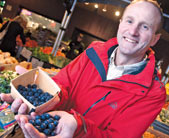Nature's little blue gems
A UVic research team gets down to the genetic nitty gritty on why blueberries are good for us

Constabel, with a winter crop
of blueberries at local
green grocer The Root Cellar,
in Saanich.
PHOTO: UVIC PHOTO SERVICES
Blueberries are one of our favourite fruits and no wonder—they're tasty and they're very good for us. They're rich in antioxidants, substances that can help reduce the natural cell damage in our aging bodies that can lead to cancer, heart disease and other ailments.
A research team led by UVic plant biologist Dr. Peter Constabel became the first in the world to reveal—at a molecular genetic level—how blueberries ripen and produce antioxidants known as flavonoids.
"We already knew a lot about the chemical composition of blueberries, but until this study, very little about how flavonoid antioxidants are formed by the fruit as it ripens," says Constabel. "This knowledge has tremendous potential for BC's blueberry industry and, ultimately, for our health."
Canada is the world's third-largest producer of high-bush blueberries. Ninety-eight per cent of the country's $1-billion blueberry crop comes from BC where more than 800 farmers produce over 40 million kg of berries annually.
"Plant breeders can use our results to select for high antioxidant berry varieties and to try and get greater control over the ripening process," says Constabel, noting that study partners included berry farmers, and scientists from a range of government agencies in the agriculture, biotechnology and horticulture sectors.
In the study, the team used advanced genomics tools to identify a large number of genes in ripening blueberries. Genomics is the study of an organism's complete set of genes, made up of the double-helix DNA molecule that carries all the genetic instructions for an organism to function.
Constabel and his team identified genes that, as the berries ripen, are turned off during the molecular process that makes bitter (but healthy) compounds known as tannins and switched on when the berry's trademark blue-purple flavonoid pigments are produced.
In the process, the team identified more than 17,000 gene sequences, quadrupling the number of newly discovered blueberry genes—information that is now available in public databases.
With collaborators in Alberta and Oregon, the team also conducted a detailed chemical analysis of the flavonoids, and determined that the skin of blueberries contains the greatest variety and quantity of these health-promoting chemicals. And, working with researchers in Saskatchewan, they identified a plant hormone that appears to play a key role in blueberry ripening.
The study was the first of its kind to look at blueberries from a molecular and multidisciplinary perspective, says Constabel. "I don't know of any other fruit where all of these research tools have been applied in one study."
Constabel is now turning his attention to another berry in the same family, this time one that grows wild all along the BC coast. Salal berries—also packed with healthy antioxidants—were a staple traditional food for northwest coastal peoples. They picked the berries in quantity, then mashed and dried them into cakes for winter use.
"Salal has been studied for its impact on tree regeneration, but not very much for its fruit," says Constabel, who on a broad scale is interested in how and why plants, especially trees, produce biologically active compounds such as tannin.
"I find it fascinating that plant chemicals, which are produced as protection against stressful environmental conditions, can also help protect the human body. So eat your fresh fruit and grains!"
View as PDF (638K).
Grad school increases research intensity
Though the University of Victoria was founded around the heritage of two undergraduate institutions—representing teacher education and liberal arts—the launch of the graduate school in 1966 put in place a strong foundation for stratospheric growth.
The rise and diversification of graduate programming and enrolment quickly helped distinguish UVic as a university where students could take charge of increasingly challenging scholarship and research—a path that has also led to research-enriched undergraduate curricula.
"Graduate students generate energy, excitement and interest in their research and scholarship that is vital to all members of the university," explains Dr. David Capson, dean of graduate studies.
"From humble beginnings, we now offer more than 160 graduate programs in all nine faculties and two divisions. And as future leaders, our grad students carry the UVic traditions of inquiry and engagement into their careers throughout the world and contribute to our reputation."
Info: http://bit.ly/SC1jni
